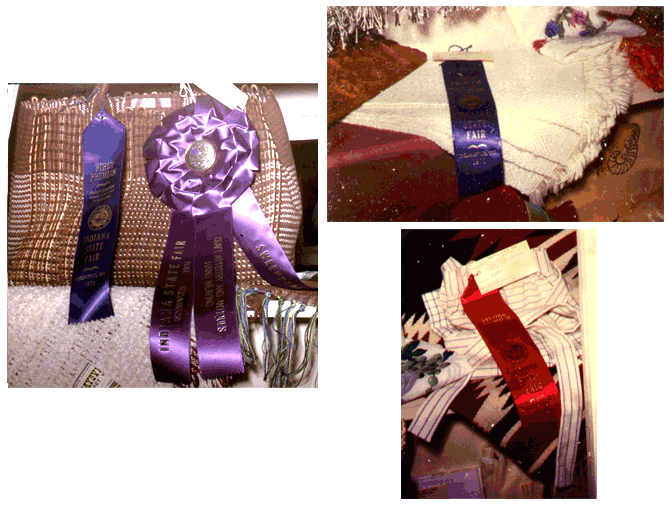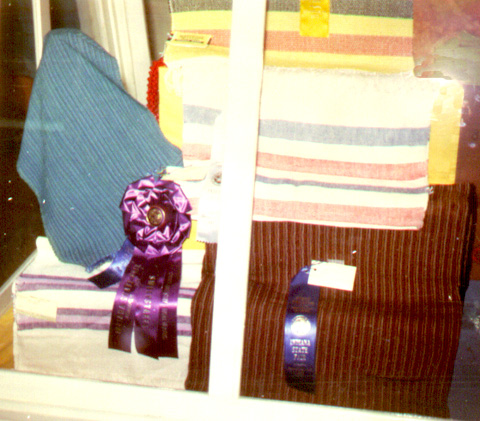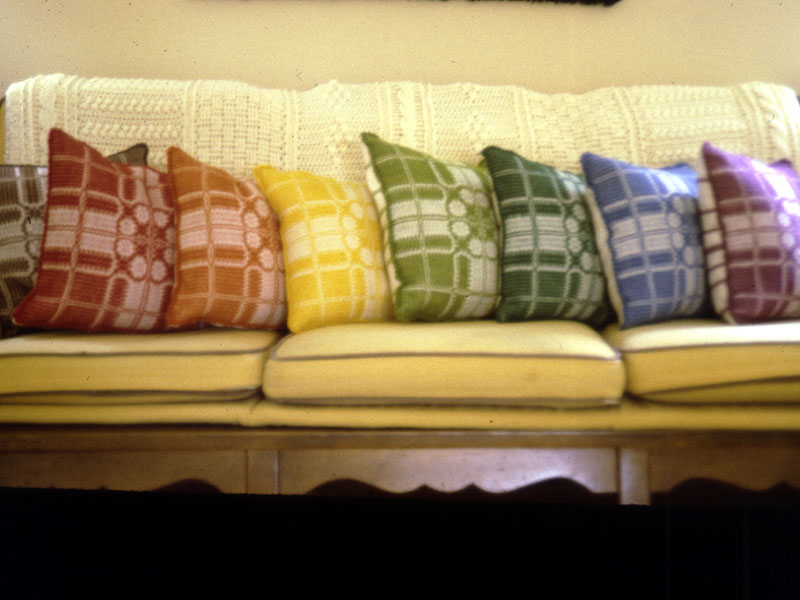52 Ancestors,
in 52 Weeks
Week 20:
Textile

Textile: Weaving
 My mother, Betty LaFara, began weaving in the mid-1960s. [1] She became interested in weaving when she was helping a Girl Scout troop with their Textile Arts Badge. Soon after, my father bought her a loom. It was old and needed repair, which he happily did, and I now wonder if that was really why he bought it. That first loom was fairly basic, just four harnesses and small enough to sit on a card table. After cutting her weaving chops on that first loom my mother soon moved on to an eight harness, floor loom. It was large enough for nearly any project she could design. Over the years, my mother has made all sorts of beautiful hand-woven textile items.
My mother, Betty LaFara, began weaving in the mid-1960s. [1] She became interested in weaving when she was helping a Girl Scout troop with their Textile Arts Badge. Soon after, my father bought her a loom. It was old and needed repair, which he happily did, and I now wonder if that was really why he bought it. That first loom was fairly basic, just four harnesses and small enough to sit on a card table. After cutting her weaving chops on that first loom my mother soon moved on to an eight harness, floor loom. It was large enough for nearly any project she could design. Over the years, my mother has made all sorts of beautiful hand-woven textile items.
Indiana State Fair [2]
Many of the photos I do have are because she received recognition for her talent at the Indiana State Fair and, therefore, photographs were taken. My mother received the “Sweepstakes” purple ribbon for weaving four years in a row. The 1967 sweepstakes was awarded for the fabric she used to make herself a two-piece suit. It was a lovely shade of blue and the photo does not do it justice, I wish I had one of her wearing it!
In 1968 the weaving sweepstakes was awarded for the fabric my mother wove to make drapes for the large window in our living room. That year she also won two blue ribbons and a red ribbon. In 1969 the sweepstakes was awarded for fabric she wove featuring the use of leather strips and fashioned into a tote bag. She won a blue and red ribbon, also, that year. In 1971 the sweepstakes went to the blue-green fabric my mother later used to make a vest. The brown fabric in the photo won a blue ribbon and she used it to make a poncho-like cape.
Instructing
My mother’s recognition at the Indiana State Fair for her weaving led to many weavers seeking her out for instruction. She taught weaving lessons at a shop in Broad Ripple called the Craft Kaleidoscope for many years. She also did demonstrations at craft fairs, art shows, museums, and schools. One place she demonstrated was Connor Prairie Farm which is a living history museum and she wore a historical costume and wove on a 19th-century loom in a log cabin!
I wrote about my mother being a competitive weaver on a sheep to shawl team for the week 42 prompt last year, Sports. [3]
Clothing
After weaving a large piece of fabric, most weavers do not want to cut the cloth. Although my mother did make many tailored items from her hand woven fabrics, she preferred to make loom-shaped clothing. She designed these projects to use whole pieces, usually rectangles, to make tunics, vests, dresses, and skirts. While doing genealogy research I often come across ancestors who may have been weavers. In their estate papers, I find references to personal property items that include spinning wheels, looms, fabric on hand, and sheep. I like to imagine my ancestors shearing their own sheep, spinning the wool, and weaving cloth for clothing. Possibly they fashioned clothing much the same as my mother did, by letting the loom dictate the shape.
Home Decor
In addition to clothing, my mother made various home decor items, big and small. Pictured here is a sampling of the hand-woven projects she made. The photo of her at the loom with the purple fabric is a rug she wove for me, actually 3 rugs, and I still have them. That large loom was found in a barn, in pieces, in very poor condition. My father spent months cleaning, repairing, and making parts for the old loom. The only room in our house large enough for the loom was our basement. And, when we moved in the late-70’s the new house had no space for that big, old loom.
Conclusion
I wish I had more photos of my mother’s various hand-woven, textile items. She made so MANY over the years. When my parents downsized 20 years ago my mother sold her largest looms. Then, about 15 years ago, she gave up weaving (mostly) and took up a new textile passion: quilting.
A very small sampling of my mother’s quilts. Click on one to see a larger view.
Week 19: Food and Drink
Besides prizes for weaving, my mother also won a few Indiana State Fair ribbons for her jellies. Pictured here are her blue ribbon mint jelly, red ribbon grape jelly and white ribbon currant jelly.
SOURCES:
- Blog post, Family Finds: Mother; https://barblafara.com/mother/
- Web page, Indiana State Fair: Competitions and Contests; https://www.indianastatefair.com/p/state-fair/competitions–contests
- Blog post, Family Finds: Sports; https://barblafara.com/sports/
2 Comments
Submit a Comment





























This is a wonderful post. You put some much into your stories. Thanks for sharing. I couldn’t think of what to share on this theme.
I know how that goes, I could not think of anything last week… Thanks for stopping by and leaving a comment.